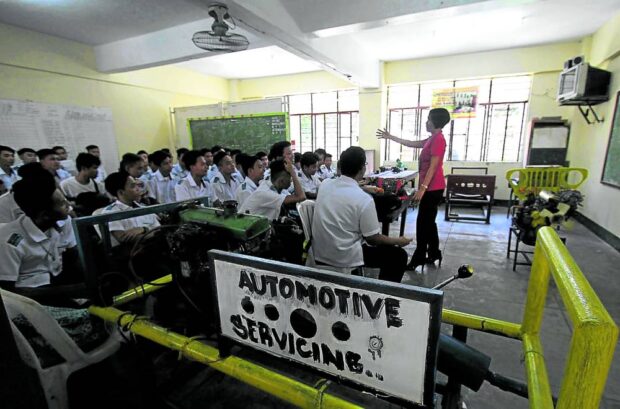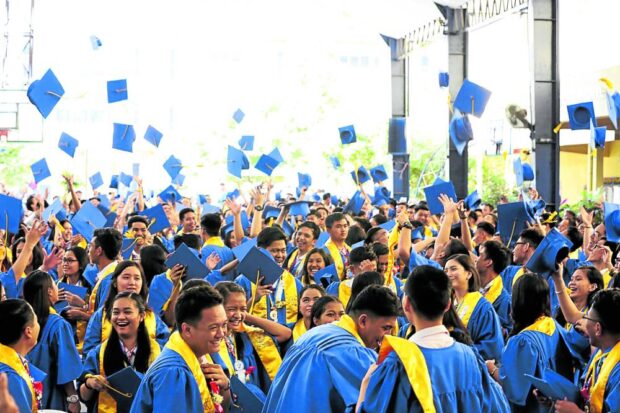A decade of tweaking, rethinking: Looking back at K-12 program

IT GETS TECHNICAL Grade 11 students taking the technical-vocational-livelihood track under the K-12 curriculum are introduced to the subject of automotive servicing, in this photo taken on June 13, 2016, at Parañaque National High School in Parañaque City. —RICHARD A. REYES
A decade ago, the government rolled out the K-12 program.
Back then, the Philippines was one among only three countries with a 10-year preuniversity cycle. The rest of the world was operating on a 13-year program: required kindergarten, six years of elementary school, four years of high school, and two years of senior high.
K-12 was supposed to put the Philippines on the same level as the rest of the world, so that those seeking entry to foreign universities wouldn’t have to take two more years of high school, and those who had to enter jobs that required a specific number of years in school wouldn’t find themselves set aside in favor of those who followed the world standard.
The program was noble in its intentions: the first few years of school were designed to contextualize learning so that students could better appreciate the role of the lessons in their daily lives, rather than see them as mere pieces to be memorized in a textbook.
It also promised spiral learning, where classes were not taken as subjects specific to a year level (Ex: biology in sophomore year of high school, chemistry in junior year, physics in senior year) but were taught as basic concepts in each year level, and then built up in succeeding years with more advanced lessons.
The two extra years of senior high, moreover, had a tracking system to help students choose the subjects which they believed they would need in their careers. The extra years were also laid down as a means for learners to choose what they wanted to do post-high school: aside from the traditional college route, they could seek out employment early, put up their own business, or pursue a trade —activities that are in demand in other countries, where four-year college degrees are not required for certain tasks.
There, too, was the promise of a mother tongue language curriculum, where students learned concepts in their mother tongue, and English as a foreign language, to give them the mental framework to absorb new concepts without having to work on both understanding them and translating them from a language that they neither spoke nor thought in.
READ: Half of Filipinos dissatisfied with K-12 program – SWS
Early reactions, results
What met the K-12 program was anger.
Parents felt that they were burdened with two extra years of spending for their children’s tuition, in what they perceived was a program that had been forced onto them rather than introduced gradually.
Elementary and high school teachers were worried about the extra training that they would have to undergo, because the pedagogy of K-12 was learner-centered, which was unlike the lecture-centered pedagogy in which they had been taught.
We, at the university level, saw a slump in enrollment, as two cohorts spent their two extra years in the classroom. We, too, had to advance our curricula to remove what we were told were redundancies with senior high school subjects. We were nevertheless hopeful that with the promised extra training (including research), our students would be more critical, think more systematically, and not be alien to the idea of pursuing systematic work.
Eight years ago, one of my thesis groups studied how students in a public senior high school made decisions on their tracks. The results were interesting: the students had their own aspirations on what they wanted to pursue, but they ultimately followed their parents, who were in charge of paying their tuition. They knew what the tracks were for, but reality was harsh: no employer would accept anyone on a senior high diploma.
That thesis is something that I’ve seen repeated, across research and even in anecdotal evidence. A review of years of Philippine K-12 research, conducted by researchers from the Bukidnon State University and published in 2022, showed that while parents appreciated that their children could choose their careers, they still saw K-12 as a financial burden. Teachers felt that they needed more training in a learner-centered curriculum. Students felt that the curriculum was crammed with topics that gave them no time to think about what they were learning.

A BATCH TO WATCH Students at Quezon City Science High School celebrate at the end of commencement exercises marking their completion of Grade 12 under the K-12 program. Photo taken on April 6, 2018. —JOAN BONDOC
READ: K-12 program needs ‘constant updating’ to keep up with times, says Villanueva
Uneven, mismatched
Sadly, the feeling of a congested curriculum is not new: as far back as 2014, students in a Philippine Normal University study said that they could not feel any increasing mastery of learning in the spiral model of instruction.
Research from the Cebu Technological University, published in 2020, showed the same findings. Though K-12 was envisioned as a way to meet global standards and to loosen up a congested curriculum, teachers piled on even more concepts into the years of schooling.
Standardized tests on abstract learning, mathematics and reading comprehension showed that those taking courses in the business and science tracks performed at above-average levels, while those in the social sciences/humanities and general tracks received average scores—disappointing, given that the humanities and social sciences tracks require very strong reading comprehension and abstraction.
These findings might not be surprising, since the curricula for different subjects within K-12 are also inconsistent. Research from the National University, published in 2021, showed that some classes focused explicitly on getting students ready for the future, while others did not; the application of a learner-centered curriculum was largely uneven; and though there was much reflective learning, there was no critical thinking being put forward in the curriculum.
There is still a mismatch between the K-12 content and college demands. At the Ateneo, our students come with research experience, but their experience does not match the rigor required of the research process. For instance, they are taught that qualitative research is easy, and they tend to disengage in college when they come face-to-face with the true nature of in-depth work.
READ: DepEd forms task force to review K-12 program
Assertive, but . . .
While our students are assertive and speak critically about social issues, their writing is disorganized: some don’t know what an outline is for, or how to create one. We do our best to fix their work, but from one semester to the next, we find that our students keep reverting to their bad writing habits.
When I confronted a student about making the same mistakes in both flow and sentence structure, he promptly shrugged, “Our high school teacher never corrected us and I got high grades for writing then.”
Many of our students dislike reading; some even claim that they are good writers but don’t like to read, and don’t need to read. Others feel that writing is not a necessity when one can make money being an online influencer. And yet very few realize that the act of writing also betrays an act of selflessness, a consideration of the reader and their needs; as well as an act of organization, a careful examination of ideas.
We were promised a more mature batch of students, but in many ways, the students still feel like children. Some of them require a good deal of handholding, constant pressure or encouragement to keep on going even when they face rejection and critique, constant prodding to think beyond their social circles and comfort zones.
Some don’t ask questions and then blame their teachers when they misinterpret instructions. Others are crammers: they believe in having classes all the way from 9 a.m. to 6 p.m., with no breaks, to save time on commutes—and then they get angry when their work quality suffers.
Multiple factors
It is easy to pin the blame on K-12, but there is much to be considered here before we look to the education system.
There are parents who have given their children everything, to the point that their children believe that anyone should sacrifice their lives on their behalf with little to no effort on the students’ part. There are parents who refuse to critique their children, who even attack teachers for correcting their children’s mistakes. In such a state, students are emotionally crippled, unable to reflect on their own work and its imperfections.
There are schools that did not implement the program faithfully: teaching a learner-centered rather than lecture-centered curriculum is not intuitive. Teachers have to listen closely to their students, work from their students’ context, incorporate this context constantly in their lessons. This is tiring for teachers who have to create lesson plans while tending to their families, managing large classrooms, budgeting their materials and carrying out administrative duties—all on low salaries.
There is the Department of Education itself, which keeps changing the contents of the curriculum, so that it cannot be assessed reliably. The changes also make teaching more difficult, as teachers have to keep rewriting their already well-laid plans.
There is social media, where the algorithms feed students with an echo chamber of similar views and opinions, where there is hardly any invitation to think critically, or to at least respect other peoples’ opinions and seek to understand them.
There is a general culture of pushing students to be obedient to their parents and stand by their elders even when those parents and elders are wrong— to do things unquestioningly, which yet again contradicts any effort to teach critical thinking.
And for some families, there is a need to simply survive, so that any school is a ticket out of poverty—a diploma on the wall is a promise of a better future, regardless of whether that diploma was well earned or made from a mill of teachers teaching students in whichever way they please.
Building blocks
The first cohort of the K-12 system, those who had the extra two years of senior high, graduated in 2022. They were also the batch that spent two years of college in isolation due to the pandemic, which made them feel alienated from learning, angry at systems that seemed to be experimenting on them with neither reason nor motivation, skeptical at efforts to teach them lessons which they felt were outdated. Online learning also makes it difficult to assess whether K-12 works, and for the purposes intended.
The K-12 program is noble in its intentions, but for it to bear fruit, it should also have been ensconced in a system where employers were first consulted on their needs, so that they could ultimately take on senior high graduates; where college professors should have figured in the discussion, so that they could present what they believe is the ideal college student; where teachers were first trained, for years, to work with learners closely rather than rely on a one-way lecture format; where lessons were created on the basis of quality rather than quantity.
Without these building blocks, K-12 becomes yet another band-aid solution to deeper systemic problems. We still rank low on standardized tests. Our students’ skills don’t match the job market. Our college students are seemingly so tired, so indifferent to their classes, that their approach is to tick items off a list to simply call it a day.
Shouldn’t we start building the infrastructure first, before pushing 13 years of what simply looks like an old system retrofitted into a new one?
(Inez Ponce de Leon’s column Question the Box appears in the Inquirer’s Opinion section every Wednesday.)